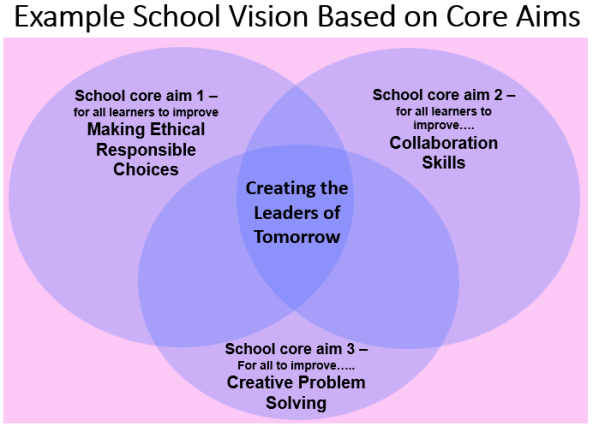Brief – In order to engage your whole school community you need to ensure firm structures for the basics then build common values and common goals around which you agree a common vision.
Agree a Mission Statement Based on 3 Core Aims
Imagine a school had the ideal culture and all of the students who went to it came out with the same shared values as the community. Would this be enough? If you ask staff this question followed by … ‘what would you hope all students would have improved by the time they leave?’ then you will arrive at a set of answers. You can choose the top three of these as your CORE AIMS or Core Goals. Arrange them as a Venn as below and here you have the basis of your school summary vision or mission statement.
Countless research pieces agree that continuous improvement be it personal or institutional is far more effective when people are clear why they are doing it. It may be a completely obvious statement but remarkably, many organisations have never taken the time to actually agree on what it is fundamentally they are trying to achieve.
OFSTED in the UK found that schools that maintained an ‘outstanding’ rating shared an insistance on having no more than three clearly stated aims. Michael Fullan through his work in Canada found the same result. These three ‘Pillars’ or ‘Core Aims’ or ‘Core Purposes’ of the school must be arrived at through processes that involve the whole community and must be clear enough to be understood and applied by all.
The Core Aims Task in this section is one I started developing in 2003 and have been building on ever since. It is a reliable way of finding out what your true aims really are. I have used it with over 20 ministries of education, with school districts, with schools in over 85 countries, with department teams, with children and parents. In brief it is a rock solid technique you can use with anyone.
Schools normally use the core aims task first with their teaching staff during a training day or extended meeting. They then, either in the same year or in subsequent years, repeat the task with other stakeholders to gain wider agreement and involve an increasing number of people from the community. To help keep track of who you have consulted with and to what degree I developed the ‘Engagement Scale’.
The Engagement Scale I started developing in 2005 and is based on Arsteins ladders of participation and Hart’s interpretation on them. Basically it is fine the first time you do the core aims task to just involve your immediate team but at some point you need more people to share your vision and share your aims. I like this scale because you can decide which group of stakeholders to target and to what level you are going to engage them.
Your three core aims need to be constantly in use and under review. Now you have decided on what they are it is critical that you act on them as soon as possible: This Monday. Any delay in using them will mean that some groups will put them on the shelf or into a policy document where they quickly become irrelevant. Before you can do this, however, you must take time to check that the three you have are strong enough to be used in every context that they need to me. Ideas for doing this are included in Step 2.
For further guidance on Step 1 see workshop 1 of the series I produced for the Microsoft Partners in Learning world wide project. The link for this can be found at www.danbuckley.net
(c) Dan Buckley
